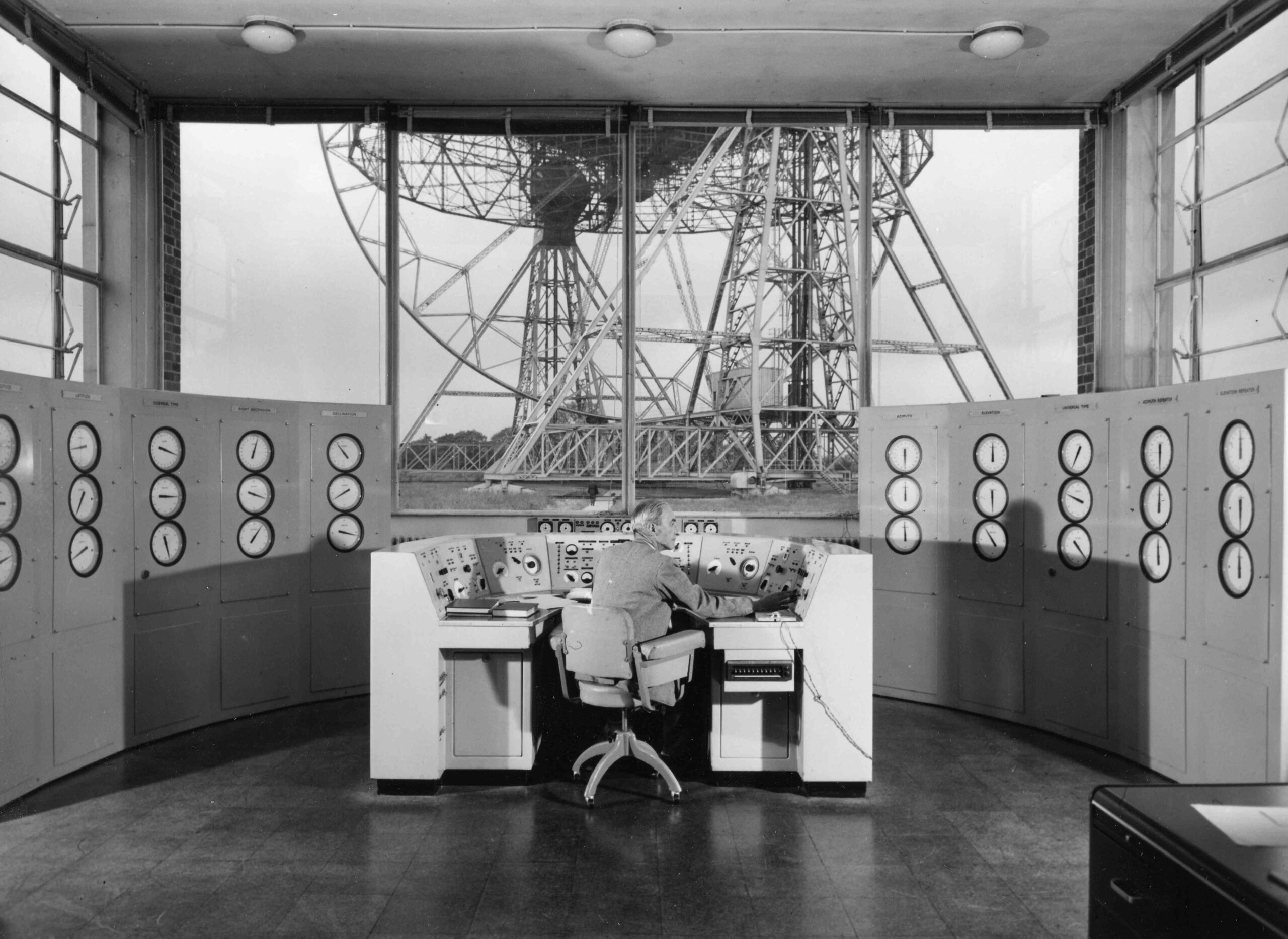
Accidental Beginnings
On a freezing cold day in December 1945 a physicist from The University of Manchester, called Bernard Lovell, drove a trailer out to a remote field in Cheshire. He wanted to see whether radar, which he had learnt about during the Second World War, could be used to study cosmic rays (high energy particles in Earth’s atmosphere).
Radar experiments outside his laboratory in Manchester had been unsuccessful because of interference from the city’s electric trams. But fortunately the University’s botany department owned some land in the Cheshire countryside. This remote location was ideal and Lovell set up his radar kit outside the gardeners’ hut. His results were good, but it wasn’t cosmic rays he had found, but meteors. This accidental discovery was the start of radio astronomy at Jodrell Bank.

image 14th December 1945, Bernard Lovell sets up his radar set outside the gardener’s huts. Copyright: University of Manchester
The new science of radio astronomy
Over the next five years, a team of scientists and technicians joined Lovell at what became known as the Jodrell Bank Experimental Station. They were building a new science: radio astronomy, studying the radio waves from space to learn about the Universe. They built their own equipment, largely from army surplus. In 1946 they built the ‘Searchlight Aerial’, mounted on top of a rotating searchlight base and used for studying meteors. In 1947 they built the ‘Transit Telescope’, a 218ft diameter wire mesh dish, and used it to detect radio waves from the Andromeda Galaxy, 2.5 million light years away.
This was an exciting time, but Lovell realised that if Jodrell Bank was to stay at the cutting-edge they needed a bigger telescope: One that could be pointed to any part of the sky and that could detect the faintest radio waves from the depths of the Universe.

image The Searchlight aerial, c.1947. Copyright: University of Manchester
Building a giant radio telescope
Engineers told Lovell that a giant radio telescope would be impossible to build, until he met Charles Husband, a bridge engineer from Sheffield. Together they designed a fully-steerable radio telescope with a 250ft diametre dish: the ‘Mark 1’, today known as the Lovell Telescope. It was to be largest radio telescope on Earth and would be at the forefront of astronomy.
Construction began in 1952, but five years later the project was in deep trouble. There had been multiple delays and the design had had to change to meet new scientific and engineering challenges. By 1957 the telescope was hugely overbudget, many had lost faith in the project and Lovell began to doubt that his vision would ever be realised.
The turning point came in October 1957, when the Soviet Union launched Sputnik 1, the first artificial satellite. This was the start of the Space Race and the eyes of the world turned to the sky. It became apparent that the near-complete telescope at Jodrell Bank was the only instrument in the world capable of locating and tracking the carrier rocket that had launched Sputnik – an intercontinental ballistic missile. Overnight the fortunes of the telescope changed, and within weeks it was fully operational.

image The telescope under construction, 1956. Copyright University of Manchester
The Space Race and Cold War
For the next decade, Jodrell Bank played a key role in the Space Race, tracking both Soviet and American space missions, receiving and sending transmissions and verifying success or failure. In 1966 the first images taken from the surface of the Moon, transmitted from the Soviet’s Luna 9 space probe, were received at Jodrell Bank. In 1969 Jodrell Bank tracked the Apollo 11 mission, following the descent of the Eagle Lander and listening in as the first humans walked on the Moon. Lovell was in the newspapers almost weekly, commenting on the new era of space exploration.
But at the same time, Jodrell Bank had a much more secret role in the Cold War. The telescope was the only device in the UK that could detect long-range missile attack, so in the early 1960s, through the height of the Cold War, Jodrell was the UK’s early warning defence system. During the Cuban Missile Crisis in 1962, RAF teams were ready to take control and point the telescope to the East.

image The signal of the descent of the Apollo 11 Eagle Lander, tracked at Jodrell Bank. 20th July 1969. Copyright University of Manchester
Pioneering science
For all the excitement of these years, space exploration and national defence were only a fraction of the work done at Jodrell Bank. The majority of telescope time was spent on science, the ground-breaking radio astronomy of Lovell’s vision.
In the decades since, Jodrell Bank has contributed to the discovery of objects and phenomena that weren’t dreamt of back in 1945. Black holes, quasars, pulsars, gravitational lenses and the fading glow of the Big Bang. Jodrell Bank has been at the forefront of a revolution of our understanding of the Universe.
Today, Jodrell Bank remains at the cutting-edge of modern astrophysics. It is home to the e-MERLIN array, a network of seven radio telescopes around the UK, which provides an exceptionally detailed radio pictures of space. In 2012 the site also welcomed the international headquarters of the Square Kilometre Array, an international project that will build and run the world’s largest radio telescope array.
In 2019 Jodrell Bank was recognised as a UNESCO World Heritage site for its pioneering role in helping to understand the Universe and our place within it. The Lovell Telescope is a Grade 1 listed building, remains the third largest telescope of its kind in the world and is still in use as a working scientific instrument.
To find out more about Jodrell Bank’s latest research, visit the Jodrell Bank Centre for Astrophysics website.

image Artist’s impression of a pulsar, Credit: Joeri van Leeuwen